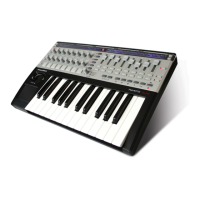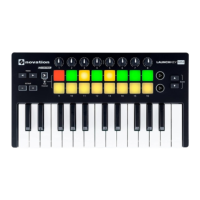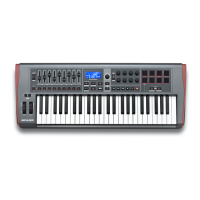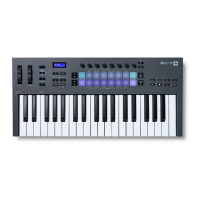35
Audio Menu Page 1 – Inputs
RE1: Input Linking
Displayed as: In12Link
Default value: Indept
Range of adjustment: Indept or Stereo
In Independent mode (Indept), separate gain adjustment is available for the two audio in-
puts (Inputs 1 and 2). In Stereo mode, the same gain adjustment is applied to both inputs
simultaneously (see RE2 and RE3 below). FX Sends from the audio inputs are linked in a
similar way (see RE7 and RE8 below).
RE2: Input 1 Gain
Displayed as: In1Gain
Default value: Off
Range of adjustment: -10 to +65
With Input Linking (RE1) set to Indept, this control adjusts gain for Input 1 only. With
Input Linking set to Stereo, gain for both Inputs 1 and 2 will be adjusted as a pair. The
parameter value is calibrated directly in dBs of gain. As the gain is increased, the signal at
the input will be seen on the bargraph meters (below RE5). The gain should be adjusted so
that the meters peak two or three segments below ‘0dB’ on the loudest passages.
automap
®
Using the UltraNova as a software controller
Automap is a software application that comes with all new Novation keyboards and controllers.
Automap should be installed on your computer, and will act as an interface between your
DAW software and your UltraNova. It communicates directly with your DAW and plug-ins,
so you have full control over other instruments and effects from your UltraNova.
The UltraNova can also be used as a computer Sound Card/Audio Interface. You can
connect audio signals from microphones, instruments and line level (+2 dBu max.) sources
and route them into your computer via USB. Furthermore, up to four audio channels from
the computer (e.g., the outputs of your DAW – the ‘Host’) may be routed through the
UltraNova to its audio outputs. DAW channels 1 & 2 may feed Outputs 1 & 2, while DAW
channels 3 & 4 may feed Outputs 3 & 4. A combination of hardware and software controls
lets you refine the mix of audio inputs, synth sounds and DAW audio channels at the vari-
ous outputs.
Note that settings made in the Audio Menu are not saved with any Patch changes. How-
ever, it is possible to save the Audio Menu settings (along with the Global Menu settings
at the same time) by pressing WRITE [23] while in the Audio (or Global) menu. This will
ensure that the next time you power up your UltraNova, these settings will be restored
instead of the original factory defaults.
The Audio Menus are opened with the AUDIO button [30]. The menu has 5 pages; pages
1 to 5 provide controls for Inputs, headphones, Outputs 1 & 2, Outputs 3 & 4, and SPDIF
Outputs respectively.
DAW SOFTWARE
DAW IN 1 + 2
DAW OUT 1 + 2
DAW OUT 3 + 4
SYNTH EFFECTS
AUDIO ROUTING IN THE DAW SOFTWAREUSB
CONNECTION
OUTPUTS 3 + 4
HEADPHONES
INPUTS 1 + 2
AUDIO ROUTING IN THE ULTRANOVA
INPUTS 1 + 2
OUTPUTS 1 + 2 SPDIF
auDIo routIng In the ultranova
Press the AUTOMAP button [26] to enter Automap Mode. The synth will no longer re-
spond to the controls. whose actions will instead be written to the . LEARN, VIEW, USER,
FX, INST and MIXER [7] are used in conjunction with the Automap software.
Full instructions for using Automap are available from
www.novationmusic.com/support.
REVERB1 Rvb1Type Rvb1Dec
LrgHall 90
GLOBAL Protect Local MidiChan MidiOut Touch/Filter
Off On 1 Off Set by Patch
TuneCent Transpse KbdVel VelResp DfltRate FootSwth Whlights
0 0 Curve 4 Medium 48KHz Auto On
ClockSource Clock} 120 BPM
Auto Status} Internal Clock
DUMP to Bank Patch Name Current OnePatch OneBank AllBanks
USBport A 0 Init Program
DUMP to ^^
USBport GLOBALS & AUDIO
Calibrate BendWhl ModWhl Aftouch SetAftouch
Current O/S Transmit ^^
Current O/S Version 1.0.00
Startup O/S Version 1.0.00
AUDIO
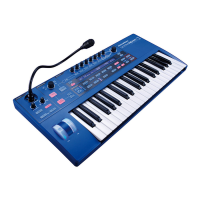
